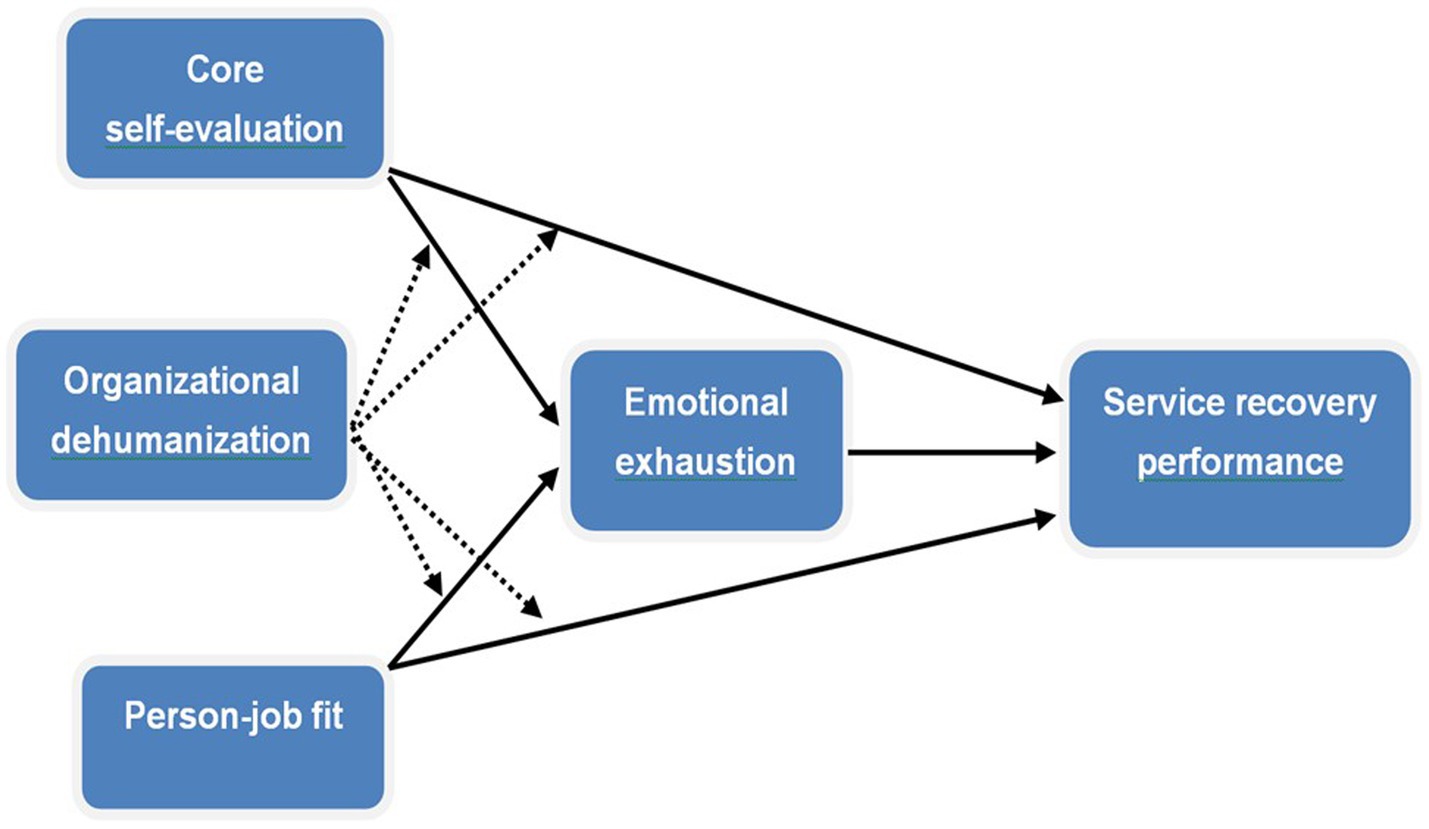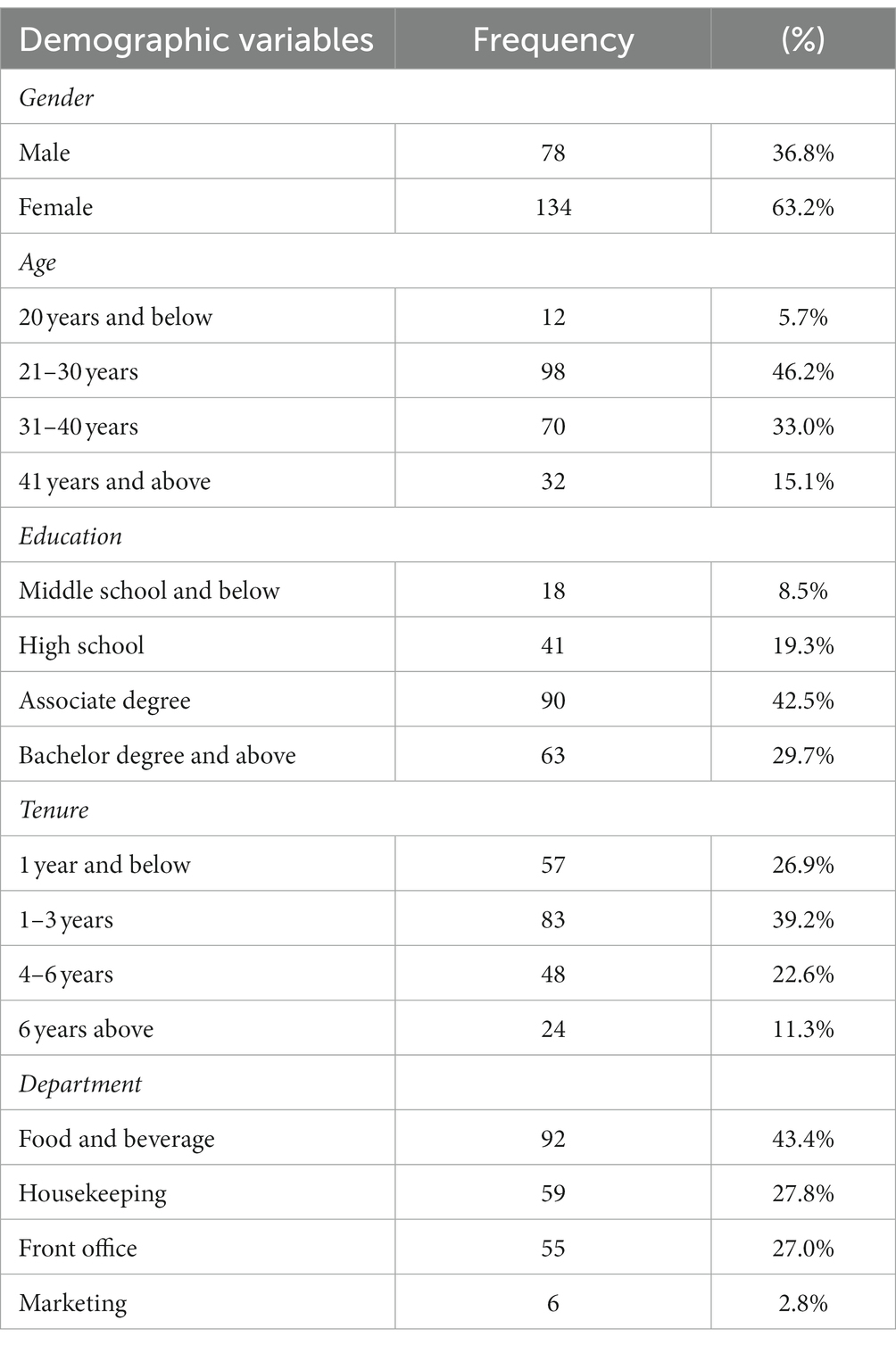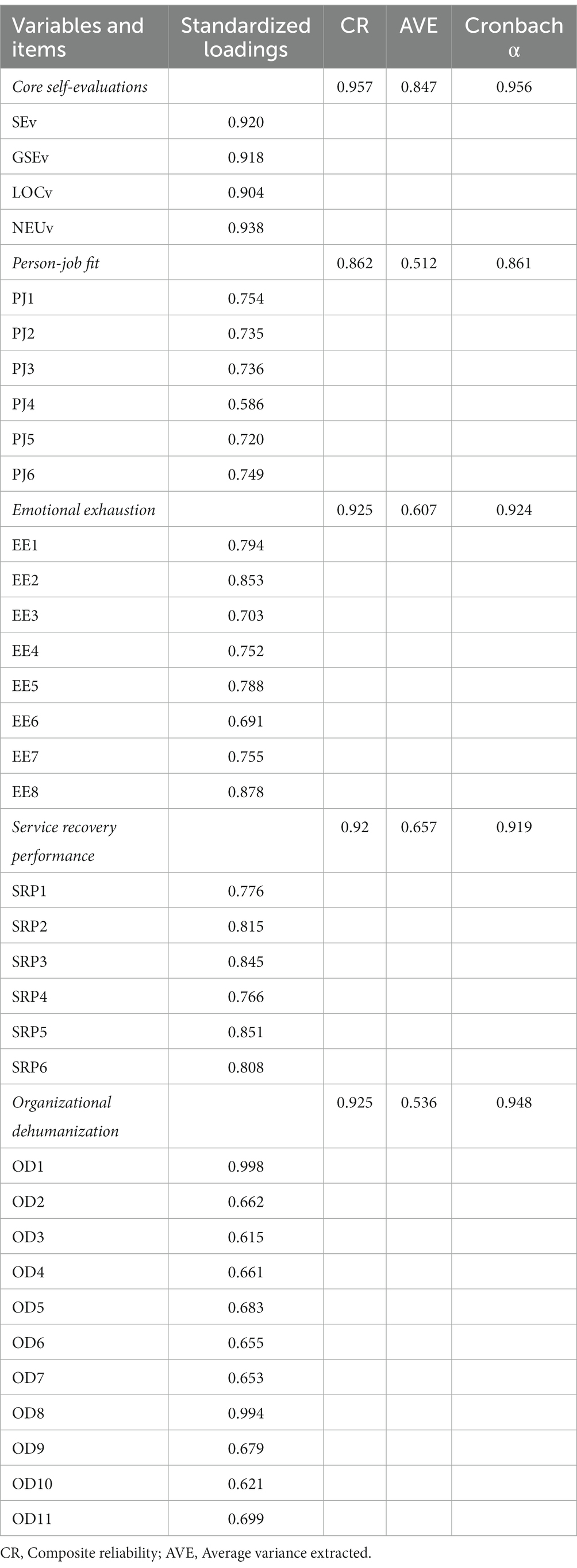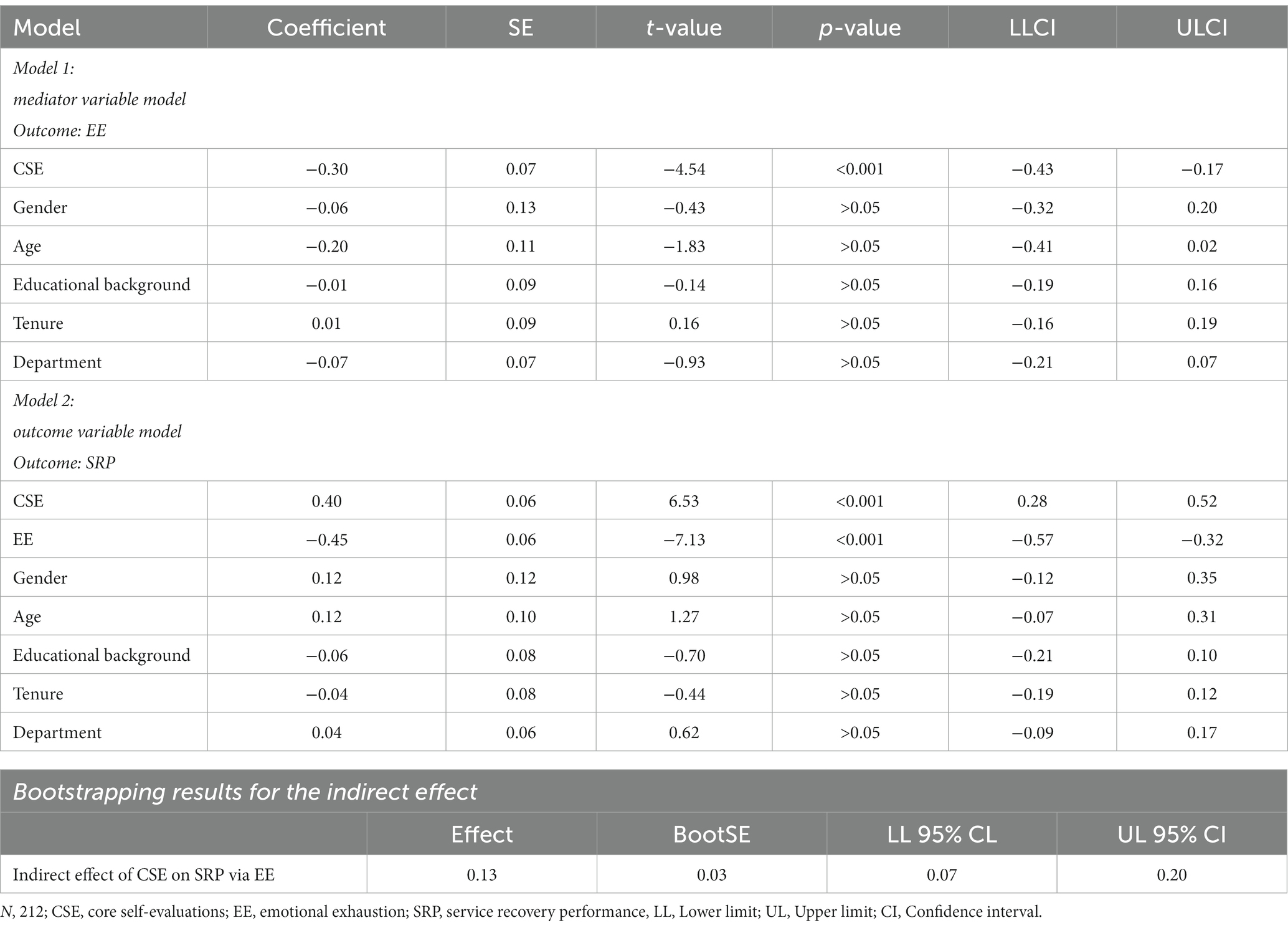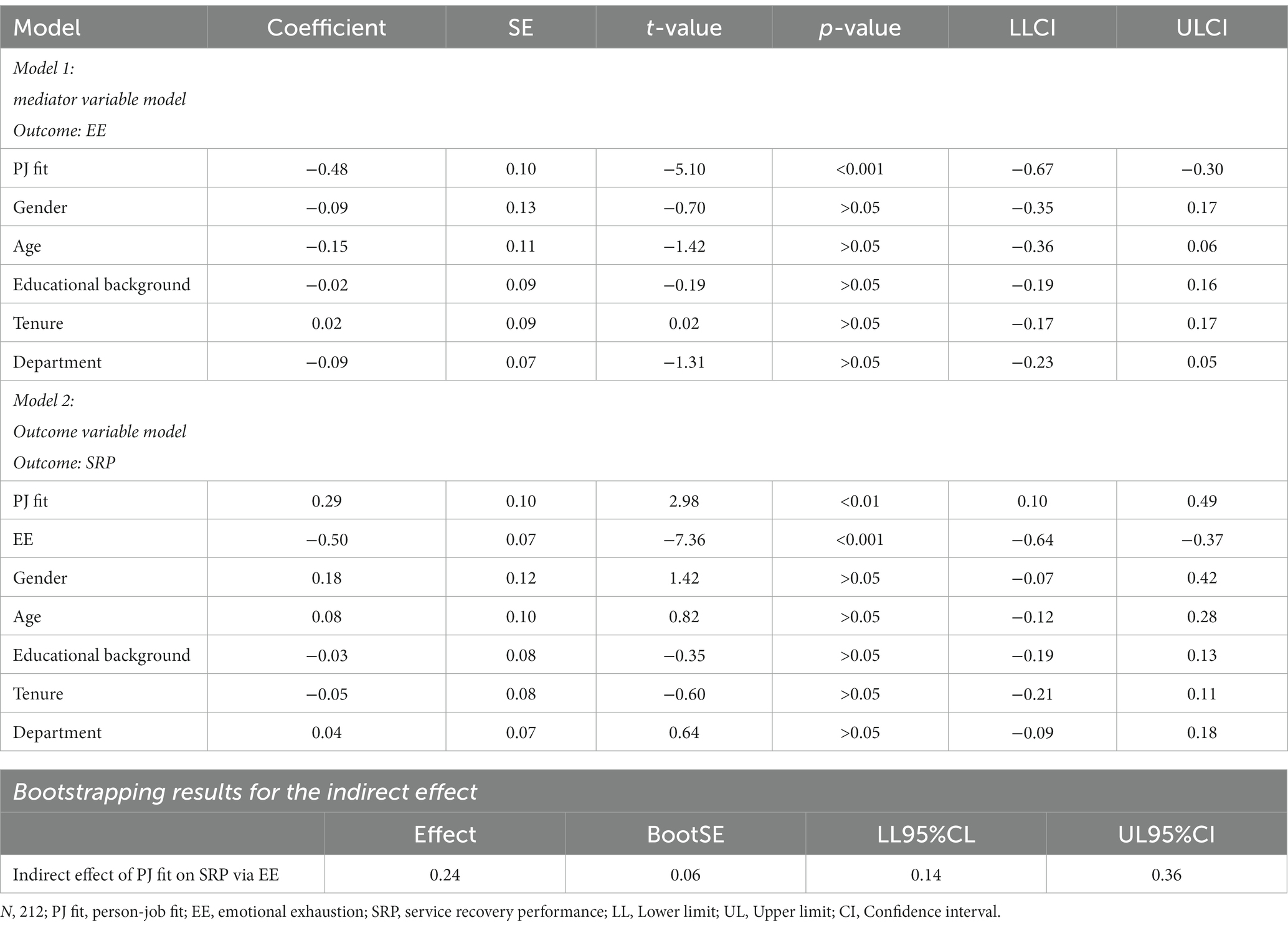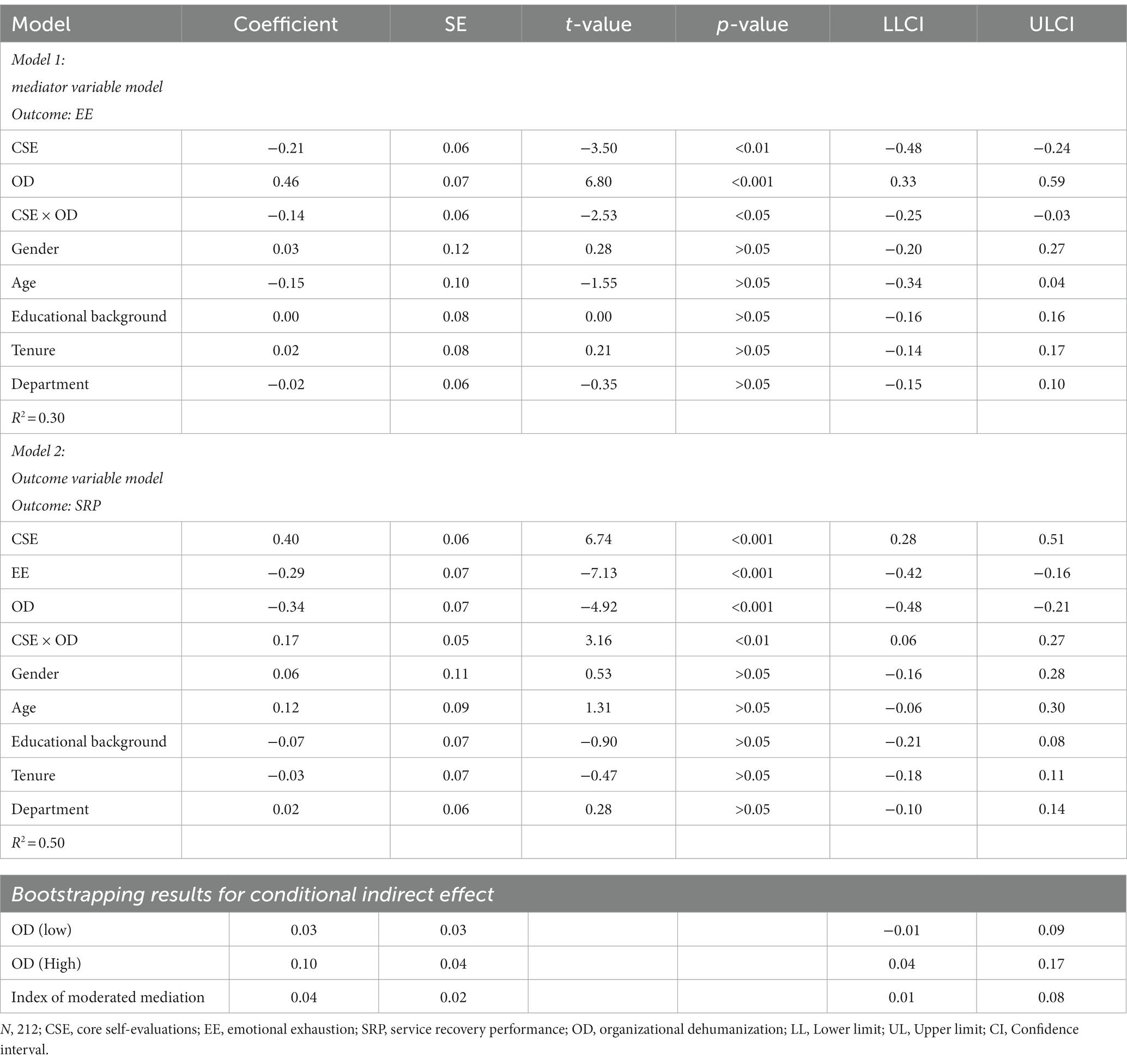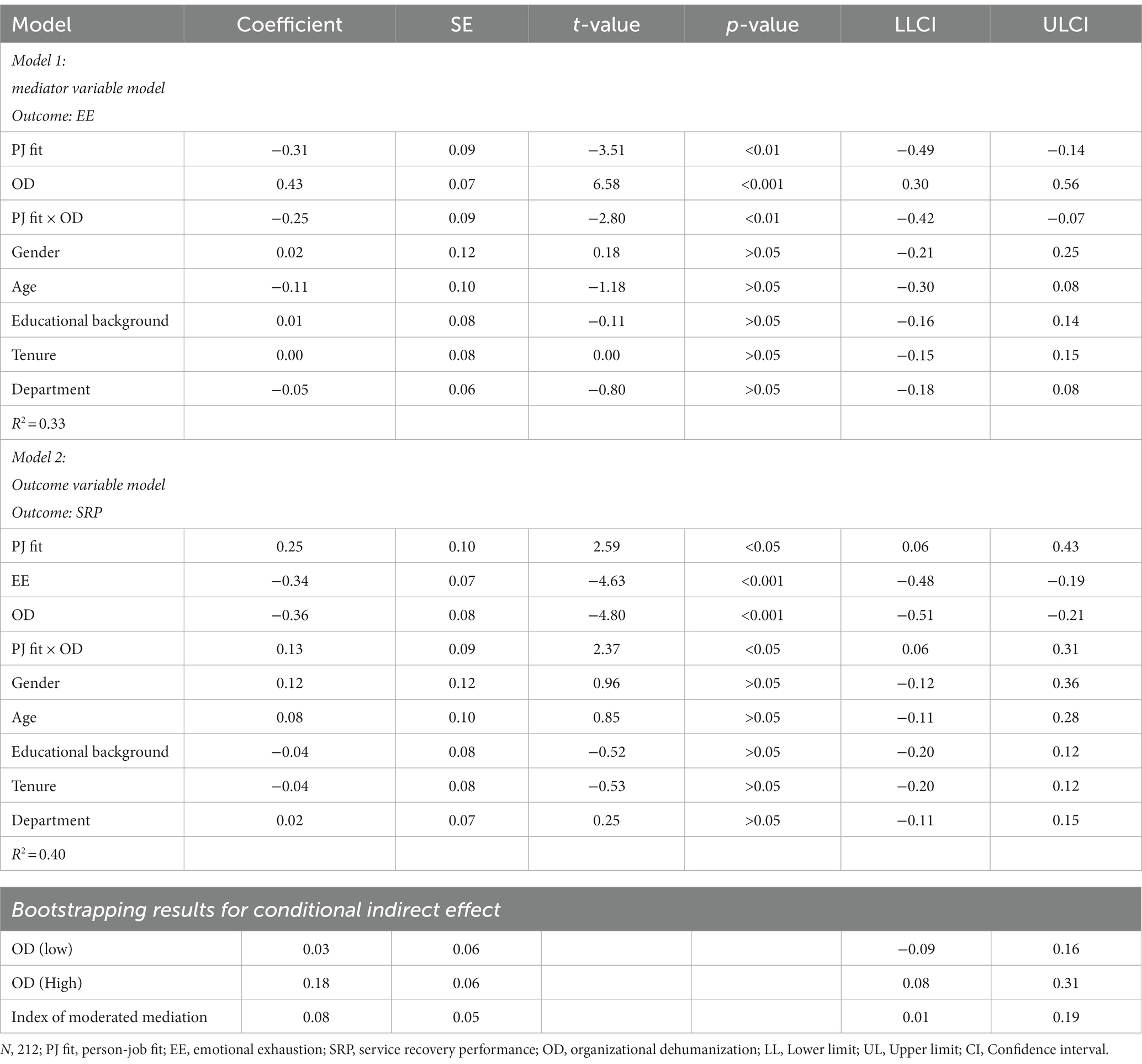- 1Qingdao Vocational and Technical College of Hotel Management, Qingdao, China
- 2North-Chiang Mai University, Chiang Mai, Thailand
Introduction: The aim of this study is to explore the mediating effect of emotional exhaustion (EE) between core self-evaluations (CSE), person-job fit (PJ fit) and service recovery performance (SRP). The current research also examines whether organizational dehumanization (OD) moderates the relationship between two antecedents, EE and SRP.
Methods: We collected time-lagged and multi-source data from star-rated hotels in three cities in China. In particular, direct supervisors of frontline employees (FLEs) rated their SRP (N = 32 supervisors and their 212 immediate employees). The hypotheses were gauged via PROCESS (version 3.4).
Results: The results indicate that CSE and PJ fit alleviate FLEs’ EE, which subsequently advances their SRP. OD moderates the direct impact of two antecedents on EE and SRP. Moreover, OD moderates the indirect influence of two antecedents on SRP through EE.
Discussion: The hospitality literature currently lacks an in-depth understanding of the underlying mechanism through which CSE and PJ fit affect FLEs’ SRP. This study incorporates EE as a mediator of the CSE’s and PJ fit’s impact on SRP, and to the authors’ knowledge, this is the first attempt to evaluate whether OD moderates the direct influence of CSE and PJ fit on SRP and the indirect impact of CSE and PJ fit on the aforementioned outcome via EE.
1 Introduction
Hospitality organizations aspire to achieve flawless service delivery, yet attaining such perfection proves exceedingly challenging. Even renowned firms acknowledged for delivering exceptional service may experience service failures (Kim and Baker, 2020). Service failure, a scenario in which service performance does not meet customer expectations, is a pervasive occurrence in the in the process of providing service (Zahoor, 2020). The actions taken by a service provider in answer to such a service failure are termed “service recovery” in the service literature. It’s worth emphasizing that effectively executing service recovery can yield a range of advantages. These encompass strengthened positive word-of-mouth promotion and heightened customer loyalty, resulting in increased economic benefits for hospitality organizations (Choi C. H. et al., 2014; Choi Y. et al., 2014; Yunus, 2023).
Existing studies provide valuable insights into job-related antecedents of service recovery performance (SRP), including factors like job demands (e.g., customer-related social stressors, workplace ostracism) (Choi C. H. et al., 2014; Choi Y. et al., 2014; Paşamehmetoğlu et al., 2022) and job resources (e.g., green human resource management, co-worker and supervisor support) (Guchait et al., 2014; Iftikhar et al., 2021). It is crucial to acknowledge that frontline employees’ (FLEs) SRP is influenced not only by job-specific demands and resources, but also by their own personal resources (Van Vaerenbergh and Orsingher, 2016). Based on conservation of resources (COR) theory, core self-evaluations (CSE) is recognized as personal resources and person-job fit (PJ fit) as conditional resources (Lee, 2015; Yan et al., 2022). These pivotal resources empower employees to adeptly navigate challenging circumstances, effectively cope with adversity and stress, ultimately culminating in workplace success (Kim et al., 2017). As such, CSE and PJ fit are posited to effectively enhance employees’ SRP in the hospitality industry.
Emotional exhaustion (EE) refers to the state of feeling emotionally overextended and exhausted due to one’s work, and it has been demonstrated to have a detrimental impact on job attitudes and behaviors (Maslach and Jackson, 1981). The pervasive effect of EE is particularly evident in the hospitality industry, where FLEs engage in numerous customer interactions which can significantly influence their attitudes and performance (Choi C. H. et al., 2014). According to COR theory, when FLEs experience EE, they may struggle to maintain satisfactory SRP due to a depletion of essential resources. Consequently, FLEs may respond negatively by reducing their SRP in order to prevent further resource depletion. Prior studies have also shown that personal and conditional resources can be effective in alleviating EE especially in the hospitality field (Chen and Eyoun, 2021; Yan et al., 2023). Hence, we employ EE to explore the underlying mechanism linking CSE, PJ fit, and SRP.
In modern hospitality sector, where work tends to be standardized, service employees are often treated as mere commodities traded in the workplace (Gip et al., 2023). When organizations manage FLEs through rigid procedures, treating them as if they were machines and disregarding their basic human needs, employees may perceive this as an act of organizational dehumanization (OD) (Gip et al., 2023). OD has become a prevalent stressor for hospitality FLEs (Muhammad and Sarwar, 2021). From the viewpoint of COR theory, CSE and PJ fit as personal and conditional resources can effectively alleviate FLEs’ stressor and strain such as OD and EE in this study. Furthermore, previous research on OD has examined its attitudinal and behavioral outcomes, such as organizational commitment, job satisfaction, EE, turnover intentions and performance in the context of hospitality (Sarwar and Muhammad, 2020; Muhammad and Sarwar, 2021; Gip et al., 2023). Thus, OD may play a moderating effect between CSE, PJ fit, EE and SRP.
The current empirical study delves into the aforementioned relationships and addresses three important research gaps. First, it explores how personal and conditional resources serve as effective remedies in mitigating EE. Specifically, CSE and PJ fit as personal and conditional resources have consistently emerged in various studies (Lee, 2015; Dong et al., 2020; Raza et al., 2023), demonstrating their capacity to enhance service quality orientations (Yavas et al., 2010). However, to date, no empirical research has examined the direct relationships of CSE and PJ fit with SRP. Second, while an abundance of empirical studies in the extant literature have proved that CSE and PJ fit can relieve FLEs’ emotional exhaustion from the perspective of COR theory (Mulki et al., 2006; Anand and Mishra, 2021), similar studies within the hospitality industry remain scarce. Finally, OD has been frequently used as an antecedent in many hospitality studies (Muhammad and Sarwar, 2021; Gip et al., 2023), nevertheless, it has never been utilized as a moderating variable between CSE, PJ fit and performance outcome. What’s more, OD has shown significant associations with various resources (Nguyen and Stinglhamber, 2021; Scrimin and Rubaltelli, 2021) and performance (Gip et al., 2023). Thus, OD has been identified as key moderating variable in the current research, which deserves more attention from both hospitality researchers and practitioners.
To summarize, the research questions of the current study are posed based on the discussion above:
• Do CSE and PJ fit have effect on SRP?
• Are there mediating effects of EE on the relationships between CSE, PJ fit and SRP?
• Are there moderating effects of OD on the relationships between CSE, PJ fit, EE and SRP?
• Are there indirect effects of CSE and PJ fit on SRP via EE which are conditional on OD (Testing the moderated mediation effects)?
Grounded in this backdrop, this study aimed to address these questions by examining the effects of CSE and PJ fit on SRP, the mediating effect of EE and the moderating effect of OD among FLEs in hotel sector in China.
2 Literature review and research hypotheses
2.1 Core self-evaluations and service recovery performance
Service recovery delineates the strategic interventions undertaken by a service-oriented entity in response to instances of service failure, wherein a customer undergoes a substandard or inequitable service encounter. The primary objective is the restoration of customer contentment, thereby securing their allegiance to the establishment (Choi C. H. et al., 2014). As previously elucidated, the adept execution of service recovery initiatives bequeaths manifold advantages, encompassing the augmentation of favorable word-of-mouth endorsements and heightened patronage, thus conferring distinct competitive advantages upon the enterprise (Casidy and Shin, 2015; Akinci and Aksoy, 2019). Within the domain of the hospitality industry, SRP assumes an imperative role in job-related proficiency. It connotes FLEs self-perceptions of their own competencies and actions in rectifying instances of service shortcoming, ultimately culminating in customer satisfaction (Yadav and Dhar, 2021).
Judge et al. (1997) introduced the concept of CSE to elucidate the psychological mechanisms that underlie dispositional influences on employee outcomes, including job attitudes and job performance. Judge and Bono (2001) specifically defined CSE as basic conclusions or bottom-line evaluations about themselves. Thus, CSE represents the fundamental assessments that individuals form regarding their own capacities, worth, and competency. Furthermore, CSE encompasses four distinct yet interconnected personal traits: self-esteem emotional stability, locus of control, and generalized self-efficacy (Judge et al., 2005).
The fundamental tenet of COR theory posits that individuals possess an innate inclination to amass, retain, and protect resources (Hobfoll, 1989). These resources encompass tangible entities like possessions (e.g., house and car), intangible attributes such as personal characteristics (e.g., CSE, PsyCap), energies (e.g., time, energy), and conditions (e.g., organizational support, PJ fit) (Hobfoll, 2001). Thus, CSE is considered as a type of personal resource. Such key personal resource empower employees to navigate demanding scenarios, effectively manage challenges and stressors, ultimately culminating in triumphant outcomes within the professional sphere (Kim et al., 2017). Employees endowed with substantial reservoirs of these resources are adept at drawing upon them in a manner akin to having an extensive font of assets at their disposal (Hobfoll, 2011).
Building on the preceding discussion, this study posits that FLEs with elevated CSE exhibits good SRP. It is incumbent upon employees to diligently adhere to the delineated tasks within their job descriptions and earnestly attend to customer grievances. They should stand prepared to adeptly navigate challenges and address complaints. In accordance with COR theory, individuals with heightened CSE possesses an augmented reservoir of resources, affording them enhanced capacity to pursue and attain their objectives (Karatepe and Talebzadeh, 2016; Yan et al., 2022). Consequently, it is anticipated that under such circumstances, employees will manifest superior workplace performance. However, empirical studies directly testing the impact of CSE on performance-related variables are scarce. Furthermore, none of these extant studies have simultaneously assessed the collective influence of CSE components on SRP. Accordingly, we advance the following hypothesis:
Hypothesis 1. CSE may positively influence SRP.
2.2 Emotional exhaustion as a mediator (CSE → EE → SRP)
CSE constitutes a pivotal trait capturing an individual’s fundamental appraisals of their environment, thereby distinguishing individuals from one another (Anand and Mishra, 2021). Those possessing high level of CSE exhibits a positive self-regard, evincing confidence, self-assuredness, and heightened motivation (Ferris et al., 2011). Furthermore, they manifest resilience and a general contentment with both professional and personal spheres (Judge et al., 2002). Such individuals perceive themselves as proficient in problem-solving (demonstrating high self-efficacy), deserving of respect and esteem (exhibiting high self-esteem), in command of and accountable for their circumstances (embracing an internal locus of control), and inclined toward optimism while being largely impervious to doubts and anxieties (enjoying high emotional stability) (Judge and Kammeyer-Mueller, 2011). Consequently, employees characterized by positive CSE are poised to adeptly navigate and manage stressors and strains. Notably, self-esteem, generalized self-efficacy, locus of control, and emotional stability have been posited as intrinsic resources for alleviating challenges arising from such stressors and strains, particularly within the theoretical framework of COR theory. Therefore, it is conceivable that CSE may serve to mitigate EE among FLEs.
This study posits that the manifestation EE among FLEs within the workplace exerts negative effect on their SRP. The COR theory offers valuable insights into this relationship. Employees undergo stress when confronted with the perceived risk of resource depletion, actual instances of resource loss, or inadequate returns on supplementary resource investments (Hobfoll, 2001). Such stress is likely to precipitate feelings of EE. Under such exigent circumstances, FLEs may construe their resource reservoirs as insufficient to meet the demands of their work, thereby prompting the adoption of defensive strategies to avert further resource depletion. Specifically, this may encompass a reduction in organizational engagement and commitment, potentially culminating in compromised performance in job-related tasks, including SRP (Meyer et al., 2021).
While extant empirical investigations have examined the negative impact of EE on job performance, scant attention has been directed toward comprehending its deleterious influence on the SRP of FLEs. For example, Yan et al. (2023) observed a deterioration in both in-role and extra-role performance among hotel FLEs in Malaysia due to EE. Conversely, Yavas et al. (2008) reported no significant relationship between EE and job performance in their study involving hotel FLEs in Turkey. Grobelna (2021) demonstrated that EE functioned as a negative predictor of service performance among hotel FLEs in Poland. Choi C. H. et al. (2014) and Choi Y. et al. (2014) proved that EE significantly and negatively influenced SRP among FLEs in tourism industry in South Korea. In light of the foregoing discussion, we posit the following hypotheses:
Hypothesis 2. CSE may negatively influence EE.
Hypothesis 3. EE may negatively influence SRP.
Hypothesis 4. EE may mediate the relationship between CSE and SRP.
2.3 Person-job fit and service recovery performance
PJ fit is defined as the degree of consistency between employees’ personal characteristics and job characteristics. It can be further divided into the degree to which an individual’s ability fits the demands of work (demand-ability fit) and the degree to which individual’s needs fit what job supplied (need-supply fit) (Kristof-Brown et al., 2005). When employees have rich knowledge, exquisite technology, and strong personal ability that meet work requirements, it is demand-ability (D-A) fit; when work meets the expectation and demand of employees, it is need-supply (N-S) fit (Cable and DeRue, 2002). That is, PJ fit includes two dimensions respectively, D-A fit and need-supply N-S fit.
The COR theory posits that individuals desire to acquire, preserve, and maintain their limited resources. These resources are specifically classified into four primary categories: object resources, personality traits, conditional resources, and energy resources (Hobfoll, 1989). Drawing upon the conceptualization of PJ fit, it is regarded as a type of valued conditional resource (Hobfoll, 1989; Hobfoll et al., 2018). Consequently, in the present investigation, both CSE and PJ fit are construed as invaluable resources. These pivotal resources empower employees to adeptly navigate challenging circumstances, effectively cope with adversity and stress, ultimately culminating in workplace success (Kim et al., 2017). Simply speaking, such resources contribute to positive outcomes, as employees endowed with abundant resources possess an extensive reservoir of resources from which to draw (Hobfoll, 2011).
Of particular relevance is the facet of PJ fit, specifically D-A fit, which pertains to an individual’s congruence with the requirements of a specific job (Kristof-Brown, 2000). Employees possessing requisite abilities, knowledge, and skills commensurate with job prerequisites are anticipated to demonstrate enhanced job performance (Kristof-Brown, 2000). Therefore, it stands to reason that individuals with high levels of PJ fit will exhibit superior job performance compared to their counterparts with lower PJ fit (Yan et al., 2022). PJ fit is deemed indispensable for the pursuit of goals, as individuals fortified with ample resources evince confidence in successfully completing tasks and exhibit resilience in the face of obstacles and challenges (Hobfoll et al., 2018). Although the relationship between PJ fit and SRP has not been examined before, Lin et al. (2014) proved a significant and positive impact of PJ fit on job performance. Moreover, Kristof-Brown et al.’s (2005) meta-analysis revealed a more modest correlation between PJ fit and performance outcomes. Therefore:
Hypothesis 5. PJ fit may positively influence SRP.
2.4 Emotional exhaustion as a mediator (PJ Fit → EE → SRP)
PJ fit pertains to the alignment between an individual’s knowledge, skills, abilities, needs, and values with the requisites of a job position (Kristof-Brown et al., 2002). When employees perceive themselves as capable of meeting job demands, a sense of self-assurance and accomplishment ensues. Additionally, a state of diminished stress prevails when employees discern a close congruence between their inherent abilities and those necessitated by the job (Choi et al., 2017).
EE is defined as the feeling of being emotionally overextended and exhausted by one’s work (Maslach and Jackson, 1981). Service employees are entrusted with the responsibility of cultivating customer satisfaction and loyalty, a mandate that imposes a diverse range of cognitive, emotional, and behavioral demands (Cai and Chi, 2018). Notably, service employees are particularly susceptible to emotional labor, a phenomenon wherein organizations expect them to exhibit emotions that align with organizational objectives during interactions with customers (Rughoobur-Seetah, 2023). This requirement can result in job alienation, particularly when mandated emotional expressions deviate from the employee’s authentic sentiments (Amissah et al., 2022). In the service industry, the persistent challenges and heightened customer expectations can lead to both physical and emotional depletion (Choi C. H. et al., 2014). Indeed, employees in the hospitality and tourism sector frequently contend with negative customer reactions and verbal aggression, further augmenting their susceptibility to EE (Pu et al., 2022).
This study adopts COR theory to elucidate the impact of PJ fit on EE, subsequently influencing SRP. Specifically, COR theory suggests that an employee’s perception of possessing adequate conditional resources is inversely associated with strain such as EE. This in turn, augments their capacity for effective SRP (Mansour, 2023). We contend that such perceptions are more likely to manifest when an employee perceives their competencies as commensurate with job expectations — indicative of a high level of PJ fit. Hence, we propose the following hypotheses:
Hypothesis 6. PJ fit may negatively influence EE.
Hypothesis 7. EE may mediate the relationship between PJ fit and SRP.
2.5 Organizational dehumanization as a moderator
OD emanates from the realm of social psychology and is characterized by an employee’s perception of being objectified by their employing organization, thereby being deprived of personal subjectivity, and reduced to a mere instrument or tool for the attainment of the organization’s targets (Bell and Khoury, 2011; Gip et al., 2023; Lazaroiu and Rogalska, 2023). Koeske and Koeske’s (1993) stressor–strain–outcome (SSO) model serves as the theoretical framework for comprehending the moderating influence of OD, where OD is a job stressor, EE represents a job strain, and SRP stands as a job outcome variable (Choi C. H. et al., 2014). Aligning with the tenets of the positive stressor–strain relationship posited by SSO model, this study advances the proposition that the greater the degree of encountered OD by FLEs, the higher their levels of EE will be. Additionally, this study contends that FLEs’ experience of EE in the workplace exerts an adverse influence on their SRP, consistent with the negative strain-outcome relationship delineated within the SSO framework. Thus, this study posits that OD may play an important role in moderating the relationship between CSE, PJ fit and EE while also serving as a boundary condition affecting the indirect relationship among CSE, PJ fit and SRP. Accordingly, we hypothesize:
Hypothesis 8. OD may moderate the relationship between CSE and EE.
Hypothesis 9. The indirect effect of CSE on SRP via EE may be conditional on OD.
Hypothesis 10. OD may moderate the relationship between PJ fit on EE.
Hypothesis 11. The indirect effect of PJ fit on SRP via EE may be conditional on OD.
Hotel FLEs may indeed possess commendable personal characteristic and conditional resources, such as CSE and PJ fit. However, when they experience OD, they will tend to partake in lower levels of SRP to protect existing resources compared to those who do not experience OD. This protective inclination arises from a potential loss of motivation stemming from the depletion of existing resources, consequently impeding their capacity to effectively engage in job-related tasks, including SRP (Gip et al., 2023). Thus, this study posits that OD assumes a pivotal role in moderating the association between CSE, PJ fit and SRP. Accordingly, we hypothesize:
Hypothesis 12. OD may moderate the relationship between CSE and SRP.
Hypothesis 13. OD may moderate the relationship between PJ fit and SRP.
The framework and hypotheses of the current study have been shown in Figure 1.
3 Methods
3.1 Sample and procedures
We randomly selected 12 international five-star hotels in three cities. Subsequently, nine hotels expressed consent to participate in the study. Data were meticulously gathered from four frontline departments, encompassing front office, food and beverage, housekeeping, and marketing divisions within each hotel. The research methodology involved the deliberate application of a purposive sampling technique, coupled with the administration of online survey questionnaires. The data acquisition process was structured across two distinct waves with a two-week interval. In the initial wave, we engaged with human resource directors or managers from the hotels to provide a comprehensive overview of our research objectives. Concurrently, we distributed questionnaires to 270 FLEs employed across the nine participating hotels. These questionnaires encompassed a rudimentary introduction outlining the project’s objectives, methodology and information about the assurance of confidentiality (Podsakoff et al., 2003), coupled with a survey encapsulating respondents’ demographic particulars, CSE, PJ fit, EE, and OD. Ultimately, we received a total of 238 meticulously completed surveys. Subsequently, in the second wave, which transpired two weeks later, we dispatched a follow-up questionnaire to the immediate supervisors of FLEs who had effectively completed the initial phase. They were solicited to provide assessments of their subordinates’ SRP. We garnered responses from 32 supervisors, pertaining to a cumulative total of 212 FLEs. On average, each supervisor rated five to eight their subordinates. This engendered an impressive overall response rate of 78.5%. It is noteworthy that each questionnaire was endowed with a distinctive identifier code, facilitating the seamless correlation of respondents across the two waves of data collection.
3.2 Measurement
In this research, we selected mature scales, which have been widely utilized in the hospitality industry to ensure the reliability and effectiveness of the measurement variables. In accordance with Brislin’s (1970) recommendation, the back-translation method was diligently employed to ensure linguistic fidelity in all measurements. Additionally, the translated instruments underwent a rigorous validation process, which involved scrutiny by two departmental managers of a hotel to fortify their psychometric integrity. Based on the following five measurement tools, totally 43 items, were included in the initial model.
3.2.1 Core-self evaluation scale
The assessment of CSE was conducted employing Judge et al.’s (2005) well-established Core-Self Evaluation Scale (CSES), which encompasses 12 items gaging the four foundational facets of CSE: locus of control, generalized self-efficacy, self-esteem and neuroticism (emotional stability). A representative item for this construct is, “I am capable of coping with most of my problems.” The Cronbach’s α coefficient for this scale was 0.956.
3.2.2 PJ Fit scale
Measurement of PJ fit was predicated on the two-dimensional scale formulated by Cable and DeRue (2002), encompassing N-S fit and D-A fit, each comprised of three questions. An illustrative item reads, “The attributes that I look for in a job are fulfilled very well by my present job.” The Cronbach’s α coefficient for this scale was 0.861.
3.2.3 Emotional exhaustion scale
EE was measured employing a scale with eight items developed by Maslach and Jackson (1981), including an item such as “I feel frustrated with my job.” The Cronbach’s α coefficient for this scale was 0.924.
3.2.4 Organizational dehumanization scale
To assess OD, 11 items were drawn from Caesens et al. (2017), featuring a sample item is “My organization makes me feel that one worker is easily as good as any other.” The Cronbach’s α coefficient for this scale was 0.948.
3.2.5 Service recovery performance scale
SRP was evaluated using a six-item measure developed by Lin (2010), with a sample item “This employee is able to properly handle dissatisfied customers.” The Cronbach’s α coefficient for this scale was 0.919.
All variables were rated on a five-point Likert-type scale, ranging from strongly disagree (1) to strongly agree (5). Given previous research indicating significant impacts of FLEs’ demographic attributes on service performance, gender, age, educational background, tenure, and hotel department were included as control variables (Lyu et al., 2016; Menicucci et al., 2019).
3.3 Data analytic strategy
The current research utilized SPSS 25.0 for the analysis of the descriptive statistics and correlations among constructs. Confirmatory factor analysis (CFA) was conducted with AMOS 25.0 to test the measurement model and convergent and discriminant validity (Fornell and Larcker, 1981). The hypotheses were examined with PROCESS (version 3.4) (Hayes, 2017). To be specific, the mediating (Model 4), moderating (Model 1), and moderated mediation (Model 8) effects were evaluated.
4 Results
4.1 Respondent profile
The demographic characteristics of the sample are shown in Table 1. Nearly two thirds of the participants were female (63.2%). Regarding age, the largest group was those 21–30 years old (46.2%), followed by those 31–40 (33.0%), and those 41 years old and above (15.1%). In relation to educational background, 8.5% held a middle school diploma or below, 19.3% possess a high school diploma, 42.5% had an associate degree, and 29.7% achieved a bachelor’s degree or above. The largest group of respondents worked in the department of food and beverage (43.4%), followed by housekeeping (27.8%), and front office (27.0%). Most of them had 1–3 years of working experience in their hotels (39.2%).
4.2 Common method bias
In this research, we assured each respondent the anonymity of the survey and emphasized that there were no right or wrong answers, and we asked the respondents to answer questions as honestly as possible. Since self-report questionnaires may cause common method variance issues, the Harman single-factor test was conducted (Podsakoff et al., 2012). The result showed that the cumulative percent of first factor was 21.237% (less than the critical value of 40%), which implied that no single factor was apparent in the un-rotated factor structure. Hence, common method bias was not a serious issue in this study.
4.3 Measurement model
CFA was employed before testing the research hypotheses. In Table 2, CFA results exhibited a good model that fits the data (x2/df = 1.451, NFI = 0.970, RMSEA = 0.046, CFI = 0.973). Cronbach’s alpha coefficients and composite reliability (CR) are greater than the recommended thresholds for each variable. The average variance extracted (AVE) values were found to be above 0.5 for each construct, achieving convergent validity (Bagozzi and Yi, 1988). Additionally, as demonstrated in Table 3 the square roots of AVE were larger than the bivariate correlation coefficients, providing robust evidence for discriminant validity (Henseler et al., 2015).
4.4 Tests of mediation
As presented in Table 4, CSE (β = 0.40, p < 0.001) positively influenced SRP, thereby supporting Hypotheses 1. CSE (β = −0.30, p < 0.001) was negatively associated with EE, supporting Hypotheses 2. Moreover, EE (β = −0.45, p < 0.001) has a negative relationship with SRP. Thus, Hypothesis 3 was confirmed. Furthermore, the indirect effect of CSE on SRP through EE was significant, with 95% CI = (0.07, 0.20) which does not include 0. Hence, H4 was accepted.
As can be seen in Table 5, PJ fit (β = 0.29, p < 0.001) had positive impact on SRP, thereby supporting Hypotheses 5. PJ fit (β = −0.48, p < 0.001) was negatively associated with EE, supporting Hypotheses 6. Moreover, the indirect effect of PJ fit on SRP through EE was significant, with 95% CI = (0.14, 0.36) which does not include 0. Thus, H7 was accepted.
4.5 Tests of moderated mediation
As demonstrated in Table 6, OD significantly moderated the impact of CSE on EE (β = −0.14, p < 0.05). To better understand this moderating effect, we created a visual representation by calculating the slopes at 1 standard deviation above and below the mean (Aiken and West, 1991). Figure 2 shows the interaction pattern. Thus, OD significantly moderated the relationship between CSE and EE and hypothesis 8 was supported. The findings presented in Table 6 indicated that the conditional indirect effect was weaker in the low OD condition (β = 0.03 CI −0.01, 0.09) and stronger in the high condition (β = 0.10, CI 0.04, 0.17). Additionally, the index of moderated mediation was found to be statistically significant (index = 0.04, CI 0.01, 0.08). Hence, Hypothesis 9 was supported.
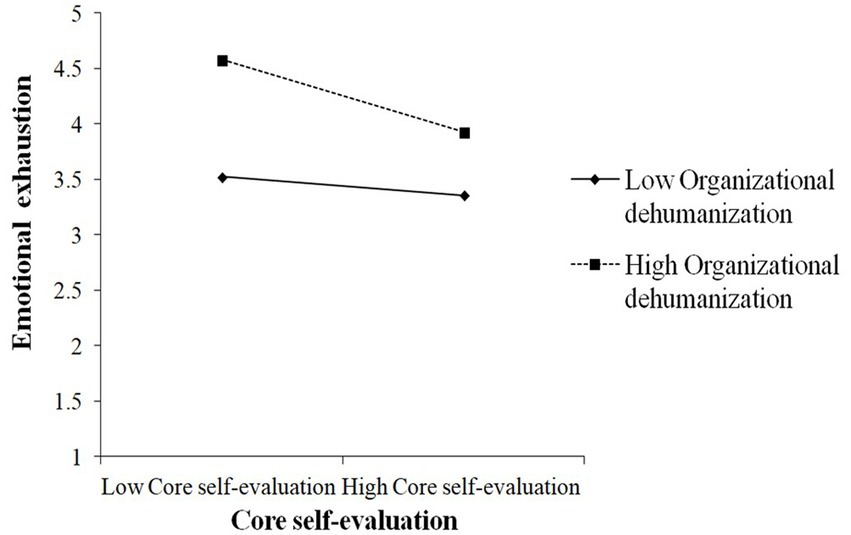
Figure 2. The interactive effects of core self-evaluations and organizational dehumanization on emotional exhaustion.
As shown in Table 7, OD significantly moderated the association between PJ fit and EE (β = −0.25, p < 0.01). To better understand this moderating effect, we created a visual representation by calculating the slopes at 1 standard deviation above and below the mean (Aiken and West, 1991). Figure 3 shows the interaction pattern. Thus, OD significantly moderated the relationship between PJ fit and EE and hypothesis 10 was supported. The findings presented in Table 7 indicated that the conditional indirect effect was weaker in the low OD condition (β = 0.03, CI −0.09, 0.16) and stronger in the high condition (β = 0.18, CI 0.08, 0.31). In addition, the index of moderated mediation was found to be statistically significant (index = 0.08, CI 0.01, 0.19). Thus, Hypothesis 11 was confirmed.
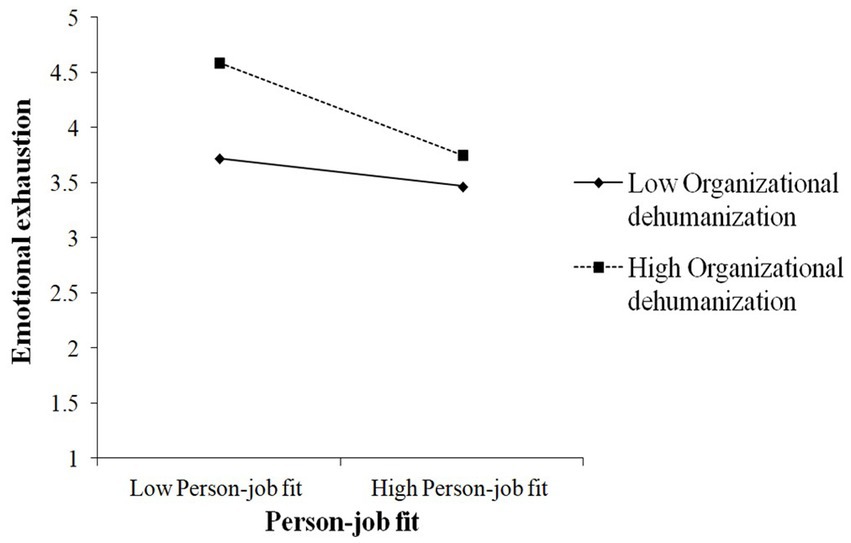
Figure 3. The interactive effects of person-job fit and organizational dehumanization on emotional exhaustion.
Furthermore, OD significantly moderated the direct association between CSE and SRP (β = 0.17, p < 0.01). This interaction pattern is illustrated in Figure 4. Thus, hypothesis 12 was supported. Besides, OD significantly moderated the direct association between PJ fit and SRP (β = 0.25, p < 0.05). Figure 5 displays the interaction pattern, affirming hypothesis 13.
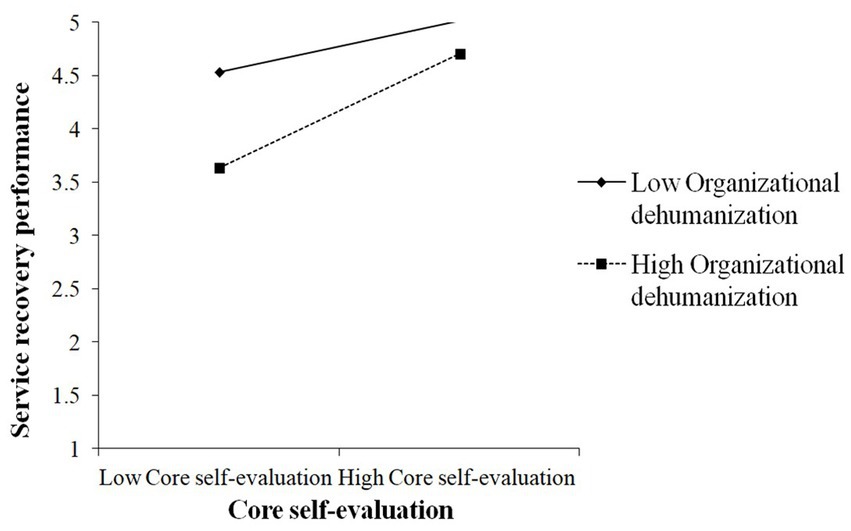
Figure 4. The interactive effects of core self-evaluations and organizational dehumanization on service recovery performance.
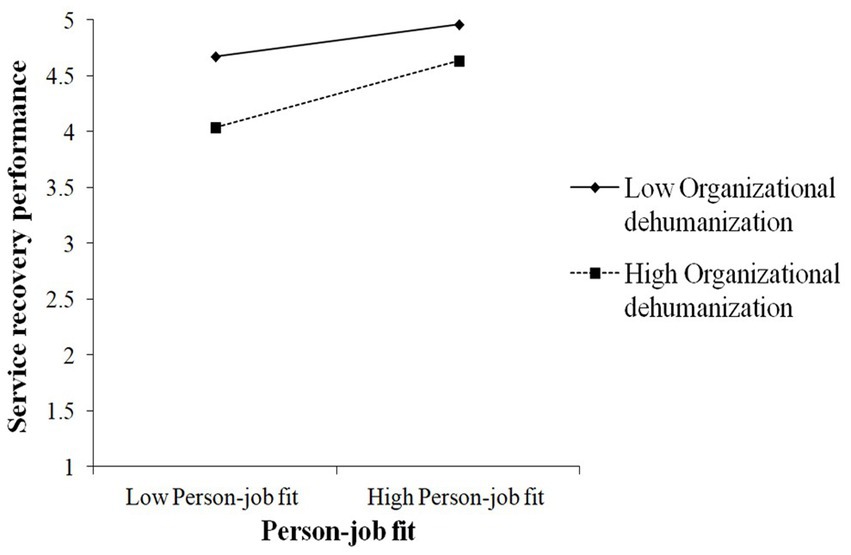
Figure 5. The interactive effects of person-job fit and organizational dehumanization on service recovery performance.
5 Discussion
In this study, we utilized a moderated mediation model shown in Figure 1 to present the relationships between CSE, PJ fit and SRP by incorporating EE and OD. Based on COR theory, this model is the first to examine the direct effect of CSE and PJ fit on SRP in the context of hospitality, as well as the indirect effect of CSE and PJ fit on the abovementioned outcome through EE, with OD as the moderator. However, most of prior studies only focused on simple effect of personality traits (such as CSE, PJ fit) on SRP (Yavas et al., 2010; Oentoro et al., 2016), without in-depth exploration on underlying and conditional mechanisms behind it. Therefore, there is a necessity to conduct this study.
5.1 Theoretical implications
The present study makes a significant contribution to the hospitality literature by investigating the influence of CSE and PJ fit on FLEs’ SRP. To the best of our knowledge, there is no prior research that has directly examined these relationships, particularly in the context of hospitality industry. Furthermore, our study stands out for incorporating personal and conditional resources into the model and it reveals that these resources exert differing effects on the outcome, which is also a noteworthy finding.
Second, given that FLEs’ SRP holds paramount importance in the fiercely competitive hospitality sector, numerous scholars have increasingly focused on its antecedents (Yao et al., 2019). However, the extant literature has predominantly centered on job-specific demands and resources, often ignoring the fact that FLEs’ personal resources and conditional resources may also significantly influence SRP. In light of this, our study addressed a critical gap by introducing CSE and PJ fit into the current understanding of how personal and conditional resources have impact on SRP.
Third, we sought to uncover a crucial underlying mechanism of SRP by including EE as a mediating variable, providing detailed insights into the process through which CSE and PJ fit influence FLEs’ SRP. The COR theory and stressor–strain–outcome model offer a valuable guideline for comprehending such a relationship. Both CSE and PJ fit relieve EE, as FLEs’ perceptions of having sufficient resources lead to reduced stress and EE. EE in the workplace can have a deleterious impact on their SRP. Employees may undergo stress when they perceive a risk of losing resources, face actual resource loss, or receive insufficient returns on their investments of resources (Hobfoll, 2001). This stress is likely to culminate in EE. Specifically, after a substantial investment of effort in their work, FLEs may come to believe that their resources are no longer adequate to meet the demands of their work. As a result, when employees’ emotional resources for handling job demands are depleted, they may face challenges in carrying out job-related tasks successfully such as SRP (Meyer et al., 2021).
Fourth, through examining the moderating role of OD, this study elucidated the boundary condition in the process wherein CSE and PJ fit influence EE and SRP. Muhammad and Sarwar (2021) argued that the concept of OD was still in its early stage in organizational behavior. Limited literature has considered that OD as an antecedent has negative impact on attitudinal and behavioral outcomes such as job satisfaction, affective commitment, deviation, psychosomatic strains and turnover intention (Lagios et al., 2021; Muhammad and Sarwar, 2021; Nguyen and Stinglhamber, 2021). This study is also the first to incorporate OD as a moderating variable to illustrate the work-stress process based on COR theory.
5.2 Practical implications
In addition to the theoretical significance, this study holds crucial implications for practitioners. First, hotel management should acknowledge the vital role of personal and conditional resources and incorporate assessments of candidates’ CSE and PJ fit in the process of selection. With reliable measurement tools like CSE and PJ fit questionnaires (Cable and DeRue, 2002; Judge et al., 2005) readily available, organizations can identify candidates with ample personal and conditional resources. This implication empowers managers to recruit individuals possessing positive personal attributes for the appropriate positions.
Second, hospitality FLEs need frequently adjust their emotions and express the emotions to align with organizational demands. FLEs frequently interact emotionally with customers, potentially leading to EE. High levels of EE among employees have negative effects on organizational outcomes, as it may result in diminished positive attitudes and reduced performance (Rathi and Lee, 2016). The current study has proved that if FLEs’ resources are depleted in coping with their job demands, their ability to execute job-related tasks, such as SRP, may be compromised (Meyer et al., 2021). Hence, the HR department should recognize that personal and conditional resources are adaptable and can be cultivated within an individual (Luthans et al., 2007). Various face-to-face and web-based interventions are available to improve FLEs’ CSE and PJ fit. Consequently, hotel management can proactively implement training programs to sustain high levels of CSE and PJ fit among FLEs. Through these programs, FLEs can learn effective strategies to protect, preserve and accumulate their personal and conditional resources.
Third, OD has low intensity compared with overt physical aggression, and is often overlooked by practitioners. The findings on OD as a stressor demonstrate its detrimental effect on the preservation of personal and conditional resources, particularly in relation to EE. Therefore, managers should devise interventions that empower hotel FLEs, making them aware that they are valued as individuals and not merely as replaceable instruments. It is imperative for hotels to recognize that prioritizing the well-being of their employees as human beings precedes concerns about their performance. Managers can foster a sense of belonging and support by implementing HR practices like reducing workload, enhancing their perceptions of job security and offering ample training and development chances for their personal growth and advancement. To counteract feelings of dehumanization among FLEs, conferences, workshops, teambuilding activities involving active interaction across various levels of management can be highly effective. These initiatives can promote engagement, respect and civility in the workplace, ultimately reducing perceived stressors among FLEs (Muhammad and Sarwar, 2021).
Finally, management should be responsible for ensuring FLEs play a central role in the process of service delivery. If management identifies FLEs who struggle with addressing customer issues and are hesitant to enhance their SRP, it may be advisable to consider replacing them with individuals who exhibit high levels of CSE and PJ fit. In conclusion, the practices outlined above are likely to empower management in acquiring FLEs high on CSE and PJ fit, mitigating their EE and thereby improving SRP.
6 Limitations and future research
While the present study provides valuable insights for both academia and practice, it is imperative to acknowledge certain limitations. First, the cross-sectional design employed in the current research constrains its capacity to definitely establish causal relationships. Despite we have made efforts to prevent or reduce the likelihood of CMB through multiple procedural approaches, its potential influence on the results cannot be entirely ruled out (Podsakoff et al., 2003). For instance, CSE, PJ fit, EI and OD were all assessed by the same respondents during the same time wave. In forthcoming investigations, alternative methodologies such as longitudinal or experimental studies are recommended to avoid or minimize CMV (Podsakoff et al., 2003). Second, we only focused on two types of resources, namely CSE and PJ fit, in relation to SRP in the hospitality industry. It is conceivable that other types of personal or conditional resources such as psychological capital, emotional intelligence, and PO fit, may also exert similar influence on FLEs’ SRP. Hence, future research should explore and compare the impacts of other types of resources on the outcome. Thirdly, the current study exclusively sampled FLEs in China, potentially limiting the generalizability of the findings. It is recommended that future research replicate this one within Western contexts to ascertain the robustness and consistency of the results. Finally, given the data may be nested within supervisors because FLEs shared supervisors, a multilevel empirical study within this topic can be conducted in future studies.
7 Conclusion
This moderated mediation model represents a notable advancement, building on previous research pertaining to CSE, PJ fit and SRP by incorporating EE and OD. This framework stands out as the first to empirically validate both the direct impact of CSE and PJ fit on SRP, and the indirect influence of CSE and PJ fit on the outcome through EE, with OD serving as the moderator. The results unequivocally demonstrated that CSE and PJ fit led to an increase in SRP and such relationships were partially mediated by EE and moderated by OD (Preacher and Hayes, 2008). Moreover, our findings shed light on the fact that OD not only intensified the association between CSE, PJ fit and EE but also bolstered the mediating effect of EE between CSE, PJ fit, and the aforementioned outcome.
Data availability statement
The original contributions presented in the study are included in the article/supplementary material, further inquiries can be directed to the corresponding author.
Ethics statement
The studies involving humans were approved by Human Subjects Ethics Committee of Qingdao Vocational and Technical College of Hotel Management. The studies were conducted in accordance with the local legislation and institutional requirements. The participants provided their written informed consent to participate in this study.
Author contributions
ZZ: Conceptualization, Funding acquisition, Supervision, Writing – review & editing. ZY: Data curation, Formal analysis, Investigation, Methodology, Writing – original draft, Writing – review & editing.
Funding
The author(s) declare financial support was received for the research, authorship, and/or publication of this article. General items of pedagogy in 2021 (The National Social Science Fund of China): Research on value-added evaluation of talent training in Higher vocational colleges (BJA210103).
Conflict of interest
The authors declare that the research was conducted in the absence of any commercial or financial relationships that could be construed as a potential conflict of interest.
Publisher’s note
All claims expressed in this article are solely those of the authors and do not necessarily represent those of their affiliated organizations, or those of the publisher, the editors and the reviewers. Any product that may be evaluated in this article, or claim that may be made by its manufacturer, is not guaranteed or endorsed by the publisher.
References
Aiken, L., and West, S. (1991). Multiple regression: Testing and interpreting interactions. Newbury Park: Sage Publications, Inc.
Akinci, S., and Aksoy, S. (2019). The impact of service recovery evaluation on word-of-mouth intention: a moderated mediation model of overall satisfaction, household income and gender. Tour. Manag. Perspect. 31, 184–194. doi: 10.1016/j.tmp.2019.05.002
Amissah, E. F., Blankson-Stiles-Ocran, S., and Mensah, I. (2022). Emotional labour, emotional exhaustion and job satisfaction in the hospitality industry. J. Hospital. Tour. Insig. 5, 805–821. doi: 10.1108/JHTI-10-2020-0196
Anand, P., and Mishra, S. K. (2021). Linking core self-evaluation and emotional exhaustion with workplace loneliness: does high LMX make the consequence worse? Int. J. Hum. Resour. Manag. 32, 2124–2149. doi: 10.1080/09585192.2019.1570308
Bagozzi, R. P., and Yi, Y. (1988). On the evaluation of structural equation models. J. Acad. Mark. Ence 16, 74–94. doi: 10.1007/BF02723327
Bell, C. M., and Khoury, C. (2011). “Organizational de/humanization, deindividuation, anomie, and in/justice” in Emerging perspectives on organizational justice and ethics. Eds. S. W. Gilliland, D. D. Steiner, and D. P. Skarlicki. (IAP Information Age Publishing). 167–197.
Brislin, R. W. (1970). Back-translation for cross-cultural research. J. Cross-Cult. Psychol. 1, 185–216. doi: 10.1177/135910457000100301
Cable, D. M., and DeRue, D. S. (2002). The convergent and discriminant validity of subjective fit perceptions. J. Appl. Psychol. 87, 875–884. doi: 10.1037/0021-9010.87.5.875
Caesens, G., Stinglhamber, F., Demoulin, S., and De Wilde, M. (2017). Perceived organizational support and employees’ well-being: the mediating role of organizational dehumanization. Eur. J. Work Organ. Psy. 26, 527–540. doi: 10.1080/1359432X.2017.1319817
Cai, R., and Chi, C. G.-Q. (2018). The impacts of complaint efforts on customer satisfaction and loyalty. Serv. Ind. J. 38, 1095–1115. doi: 10.1080/02642069.2018.1429415
Casidy, R., and Shin, H. (2015). The effects of harm directions and service recovery strategies on customer forgiveness and negative word-of-mouth intentions. J. Retail. Consum. Serv. 27, 103–112. doi: 10.1016/j.jretconser.2015.07.012
Chen, H., and Eyoun, K. (2021). Do mindfulness and perceived organizational support work? Fear of COVID-19 on restaurant frontline employees’ job insecurity and emotional exhaustion. Int. J. Hosp. Manag. 94:102850. doi: 10.1016/j.ijhm.2020.102850
Choi, C. H., Kim, T., Lee, G., and Lee, S. K. (2014). Testing the stressor–strain–outcome model of customer-related social stressors in predicting emotional exhaustion, customer orientation and service recovery performance. Int. J. Hosp. Manag. 36, 272–285. doi: 10.1016/j.ijhm.2012.09.009
Choi, Y., Lee, D., and Lee, Y. C. (2014). Psychological capital, big five traits, and employee outcomes. J. Manag. Psychol. 29, 122–140. doi: 10.1108/JMP-06-2012-0193
Choi, S. B., Tran, T. B. H., and Kang, S.-W. (2017). Inclusive leadership and employee well-being: the mediating role of person-job fit. J. Happiness Stud. 18, 1877–1901. doi: 10.1007/s10902-016-9801-6
Dong, X., Zhao, C., Yin, H., and Chen, G. (2020). Work–family conflict affects job insecurity: the mediating role of core self-evaluation. Soc. Behav. Personal. Int. J. 48, 1–10. doi: 10.2224/sbp.8972
Ferris, D. L., Rosen, C. R., Johnson, R. E., Brown, D. J., Risavy, S. D., and Heller, D. (2011). Approach or avoidance (or both?): integrating core self-evaluations within an approach/avoidance framework. Pers. Psychol. 64, 137–161. doi: 10.1111/j.1744-6570.2010.01204.x
Fornell, C., and Larcker, D. F. (1981). Evaluating structural equation models with unobservable variables and measurement error. J. Mark. Res. 18, 39–50. doi: 10.1177/002224378101800104
Gip, H., Guchait, P., Paşamehmetoğlu, A., and Khoa, D. T. (2023). How organizational dehumanization impacts hospitality employees service recovery performance and sabotage behaviors: the role of psychological well-being and tenure. Int. J. Contemp. Hosp. Manag. 35, 64–91. doi: 10.1108/IJCHM-02-2022-0155
Grobelna, A. (2021). Emotional exhaustion and its consequences for hotel service quality: the critical role of workload and supervisor support. J. Hosp. Market. Manag. 30, 395–418. doi: 10.1080/19368623.2021.1841704
Guchait, P., Paşamehmetoğlu, A., and Dawson, M. (2014). Perceived supervisor and co-worker support for error management: impact on perceived psychological safety and service recovery performance. Int. J. Hosp. Manag. 41, 28–37. doi: 10.1016/j.ijhm.2014.04.009
Hayes, A. F. (2017). Introduction to mediation, moderation, and conditional process analysis: a regression-based approach. Alberta: Guilford publications.
Henseler, J., Ringle, C. M., and Sarstedt, M. (2015). A new criterion for assessing discriminant validity in variance-based structural equation modeling. J. Acad. Mark. Sci. 43, 115–135. doi: 10.1007/s11747-014-0403-8
Hobfoll, S. E. (1989). Conservation of resources: a new attempt at conceptualizing stress. Am. Psychol. 44, 513–524. doi: 10.1037/0003-066X.44.3.513
Hobfoll, S. E. (2001). The influence of culture, community, and the nested-self in the stress process: advancing conservation of resources theory. Appl. Psychol. 50, 337–421. doi: 10.1111/1464-0597.00062
Hobfoll, S. E. (2011). Conservation of resource caravans and engaged settings. J. Occup. Organ. Psychol. 84, 116–122. doi: 10.1111/j.2044-8325.2010.02016.x
Hobfoll, S. E., Halbesleben, J., Neveu, J.-P., and Westman, M. (2018). Conservation of resources in the organizational context: the reality of resources and their consequences. Annu. Rev. Organ. Psych. Organ. Behav. 5, 103–128. doi: 10.1146/annurev-orgpsych-032117-104640
Iftikhar, U., Zaman, K., Rehmani, M., Ghias, W., and Islam, T. (2021). Impact of green human resource management on service recovery: mediating role of environmental commitment and moderation of transformational leadership. Front. Psychol. 12:710050. doi: 10.3389/fpsyg.2021.710050
Judge, T. A., and Bono, J. E. (2001). Relationship of core self-evaluations traits—self-esteem, generalized self-efficacy, locus of control, and emotional stability—with job satisfaction and job performance: a meta-analysis. J. Appl. Psychol. 86, 80–92. doi: 10.1037/0021-9010.86.1.80
Judge, T. A., Bono, J. E., Erez, A., and Locke, E. A. (2005). Core self-evaluations and job and life satisfaction: the role of self-concordance and goal attainment. J. Appl. Psychol. 90, 257–268. doi: 10.1037/0021-9010.90.2.257
Judge, T. A., Erez, A., Bono, J. E., and Thoresen, C. J. (2002). Are measures of self-esteem, neuroticism, locus of control, and generalized self-efficacy indicators of a common core construct? J. Pers. Soc. Psychol. 83, 693–710. doi: 10.1037/0022-3514.83.3.693
Judge, T. A., and Kammeyer-Mueller, J. D. (2011). Implications of core self-evaluations for a changing organizational context. Hum. Resour. Manag. Rev. 21, 331–341. doi: 10.1016/j.hrmr.2010.10.003
Judge, T., Locke, E., and Durham, C. (1997). The dispositional causes of job satisfaction: a core evaluations approach. Res. Organ. Behav. 19, 151–188.
Karatepe, O. M., and Talebzadeh, N. (2016). An empirical investigation of psychological capital among flight attendants. J. Air Transp. Manag. 55, 193–202. doi: 10.1016/j.jairtraman.2016.06.001
Kim, Y. S., and Baker, M. A. (2020). Customers’ reactions to other customer caused service failures: the effects of tie strength on customer loyalty. J. Hosp. Market. Manag. 29, 682–701. doi: 10.1080/19368623.2020.1688218
Kim, T. T., Karatepe, O. M., Lee, G., Lee, S., Hur, K., and Xijing, C. (2017). Does hotel employees’ quality of work life mediate the effect of psychological capital on job outcomes? Int. J. Contemp. Hosp. Manag. 29, 1638–1657. doi: 10.1108/IJCHM-04-2016-0224
Koeske, G. F., and Koeske, R. D. (1993). A preliminary test of a stress-strain-outcome model for reconceptualizing the burnout phenomenon. J. Soc. Serv. Res. 17, 107–135. doi: 10.1300/J079v17n03_06
Kristof-Brown, A. L. (2000). Perceived applicant fit:distinguishing between recruiters’ perceptions of person-job and person-environment fit. Pers. Psychol. 53, 643–671. doi: 10.1111/j.1744-6570.2000.tb00217.x
Kristof-Brown, A. L., Jansen, K. J., and Colbert, A. E. (2002). A policy-capturing study of the simultaneous effects of fit with jobs, groups, and organizations. J. Appl. Psychol. 87, 985–993. doi: 10.1037//0021-9010.87.5.985
Kristof-Brown, A. L., Zimmerman, R. D., and Johnson, E. C. (2005). Consequences of individuals’ fit at work: a meta-analysis of person-job, person-organization, person-group,and person-supervisor fit. Pers. Psychol. 58, 281–342. doi: 10.1111/j.1744-6570.2005.00672.x
Lagios, C., Caesens, G., Nguyen, N., and Stinglhamber, F. (2021). Explaining the negative consequences of organizational dehumanization. J. Pers. Psychol. 21, 86–93. doi: 10.1027/1866-5888/a000286
Lazaroiu, G., and Rogalska, E. (2023). How generative artificial intelligence technologies shape partial job displacement and labor productivity growth. Oecon. Copern. 14, 703–706. doi: 10.24136/oc.2023.020
Lee, J. J. (2015). Drivers of work engagement: an examination of core self-evaluations and psychological climate among hotel employees. Int. J. Hosp. Manag. 44, 84–98. doi: 10.1016/j.ijhm.2014.10.008
Lin, W.-B. (2010). Relevant factors that affect service recovery performance. Serv. Ind. J. 30, 891–910. doi: 10.1080/02642060801935739
Lin, Y.-C., Yu, C., and Yi, C.-C. (2014). The effects of positive affect, person-job fit, and well-being on job performance. Soc. Behav. Personal. Int. J. 42, 1537–1547. doi: 10.2224/sbp.2014.42.9.1537
Luthans, F., Youssef, C. M., and Avolio, B. J. (2007). Psychological capital: developing the human competitive edge. New York, NY: Oxford University Press.
Lyu, Y., Zhou, X., Li, W., Wan, J., Zhang, J., and Qiu, C. (2016). The impact of abusive supervision on service employees’ proactive customer service performance in the hotel industry. Int. J. Contemp. Hosp. Manag. 28, 1992–2012. doi: 10.1108/IJCHM-03-2015-0128
Mansour, S. (2023). Can strategic HRM bundles decrease emotional exhaustion and increase service recovery performance? Int. J. Manpow. 44, 503–523. doi: 10.1108/IJM-10-2021-0576
Maslach, C., and Jackson, S. E. (1981). The measurement of experienced burnout. J. Organ. Behav. 2, 99–113. doi: 10.1002/job.4030020205
Menicucci, E., Paolucci, G., and Paoloni, N. (2019). Does gender matter for hotel performance? Evidence from the Italian hospitality industry. Int. J. Tour. Res. 21, 625–638. doi: 10.1002/jtr.2286
Meyer, B., Zill, A., Dilba, D., Gerlach, R., and Schumann, S. (2021). Employee psychological well-being during the COVID-19 pandemic in Germany: a longitudinal study of demands, resources, and exhaustion. Int. J. Psychol. 56, 532–550. doi: 10.1002/ijop.12743
Muhammad, L., and Sarwar, A. (2021). When and why organizational dehumanization leads to deviant work behaviors in hospitality industry. Int. J. Hosp. Manag. 99:103044. doi: 10.1016/j.ijhm.2021.103044
Mulki, J. P., Jaramillo, F., and Locander, W. B. (2006). Emotional exhaustion and organizational deviance: can the right job and a leader’s style make a difference? J. Bus. Res. 59, 1222–1230. doi: 10.1016/j.jbusres.2006.09.001
Nguyen, N., and Stinglhamber, F. (2021). Emotional labor and core self-evaluations as mediators between organizational dehumanization and job satisfaction. Curr. Psychol. 40, 831–839. doi: 10.1007/s12144-018-9988-2
Oentoro, W., Popaitoon, P., and Kongchan, A. (2016). Perceived supervisory support and service recovery performance: the moderating role of personality traits. Asia Pac. J. Bus. Admin. 8, 298–316. doi: 10.1108/APJBA-11-2015-0094
Paşamehmetoğlu, A., Guzzo, R. F., and Guchait, P. (2022). Workplace ostracism: impact on social capital, organizational trust, and service recovery performance. J. Hosp. Tour. Manag. 50, 119–126. doi: 10.1016/j.jhtm.2022.01.007
Podsakoff, P. M., MacKenzie, S. B., Lee, J.-Y., and Podsakoff, N. P. (2003). Common method biases in behavioral research: a critical review of the literature and recommended remedies. J. Appl. Psychol. 88, 879–903. doi: 10.1037/0021-9010.88.5.879
Podsakoff, P. M., MacKenzie, S. B., and Podsakoff, N. P. (2012). Sources of method bias in social science research and recommendations on how to control it. Annu. Rev. Psychol. 63, 539–569. doi: 10.1146/annurev-psych-120710-100452
Preacher, K. J., and Hayes, A. F. (2008). Asymptotic and resampling strategies for assessing and comparing indirect effects in multiple mediator models. Behav. Res. Methods 40, 879–891. doi: 10.3758/BRM.40.3.879
Pu, B., Ji, S., and Sang, W. (2022). Effects of customer incivility on turnover intention in China’s hotel employees: a chain mediating model. J. Hosp. Tour. Manag. 50, 327–336. doi: 10.1016/j.jhtm.2022.02.004
Rathi, N., and Lee, K. (2016). Emotional exhaustion and work attitudes: moderating effect of personality among frontline hospitality employees. J. Hum. Resour. Hosp. Tour. 15, 231–251. doi: 10.1080/15332845.2016.1147935
Raza, B., St-Onge, S., and Ullah, S. (2023). Abusive supervision and deviance behaviors in the hospitality industry: the role of intrinsic motivation and core self-evaluation. Tour. Manag. 98:104748. doi: 10.1016/j.tourman.2023.104748
Rughoobur-Seetah, S. (2023). An assessment of the impact of emotional labour and burnout on the employees’ work performance. Int. J. Organ. Anal. doi: 10.1108/IJOA-09-2022-3429
Sarwar, A., and Muhammad, L. (2020). Impact of organizational mistreatment on employee performance in the hotel industry. Int. J. Contemp. Hosp. Manag. 32, 230–248. doi: 10.1108/IJCHM-01-2019-0046
Scrimin, S., and Rubaltelli, E. (2021). Dehumanization after terrorism: the role of psychophysiological emotion regulation and trait emotional intelligence. Curr. Psychol. 40, 2707–2714. doi: 10.1007/s12144-019-00189-x
Van Vaerenbergh, Y., and Orsingher, C. (2016). Service recovery: an integrative framework and research agenda. Acad. Manag. Perspect. 30, 328–346. doi: 10.5465/amp.2014.0143
Yadav, A., and Dhar, R. L. (2021). Linking frontline hotel employees’ job crafting to service recovery performance: the roles of harmonious passion, promotion focus, hotel work experience, and gender. J. Hosp. Tour. Manag. 47, 485–495. doi: 10.1016/j.jhtm.2021.04.018
Yan, Z., Bai, N., Mansor, Z. D., and Choo, W. C. (2022). Effects of psychological capital and person-job fit on hospitality employees’ work-family conflict, family-work conflict and job performance: the moderating role of marital status. Front. Psychol. 13:971. doi: 10.3389/fpsyg.2022.868971
Yan, Z., Mansor, Z. D., and Choo, W. C. (2023). Family incivility, emotional exhaustion, and hotel employees’ outcomes: a moderated mediation model. Int. J. Contemp. Hosp. Manag. 35, 3053–3076. doi: 10.1108/IJCHM-05-2022-0573
Yao, S., Wang, X., Yu, H., and Guchait, P. (2019). Effectiveness of error management training in the hospitality industry: impact on perceived fairness and service recovery performance. Int. J. Hosp. Manag. 79, 78–88. doi: 10.1016/j.ijhm.2018.12.009
Yavas, U., Babakus, E., and Karatepe, O. M. (2008). Attitudinal and behavioral consequences of work-family conflict and family-work conflict: does gender matter? Int. J. Serv. Ind. Manag. 19, 7–31. doi: 10.1108/09564230810855699
Yavas, U., Karatepe, O. M., and Babakus, E. (2010). Relative efficacy of organizational support and personality traits in predicting service recovery and job performances: a study of frontline employees in Turkey. Tour. Rev. 65, 70–83. doi: 10.1108/16605371011083530
Yunus, E. N. (2023). Would compensation be necessary? The importance of service recovery strategy in e-retail delivery problems. Int. J. Product. Perform. Manag. 72, 1286–1303. doi: 10.1108/IJPPM-05-2021-0273
Keywords: Core self-evaluations, person-job fit, emotional exhaustion, organizational dehumanization, service recovery performance
Citation: Zhang Z and Yan Z (2024) The impact of core self-evaluations and person-job fit on work-related outcomes. Front. Psychol. 15:1341717. doi: 10.3389/fpsyg.2024.1341717
Edited by:
Fahmida Laghari, Xijing University, ChinaReviewed by:
Kavitha Haldorai, Florida State University, United StatesDan-Cristian Dabija, Babeș-Bolyai University, Romania
Sameh Fayyad, Suez Canal University, Egypt
Shenyang Hai, Hainan University, China
Copyright © 2024 Zhang and Yan. This is an open-access article distributed under the terms of the Creative Commons Attribution License (CC BY). The use, distribution or reproduction in other forums is permitted, provided the original author(s) and the copyright owner(s) are credited and that the original publication in this journal is cited, in accordance with accepted academic practice. No use, distribution or reproduction is permitted which does not comply with these terms.
*Correspondence: Zhen Yan, eWFuemhlbjExMTVAaG90bWFpbC5jb20=
 Zongguo Zhang1,2
Zongguo Zhang1,2 Zhen Yan
Zhen Yan